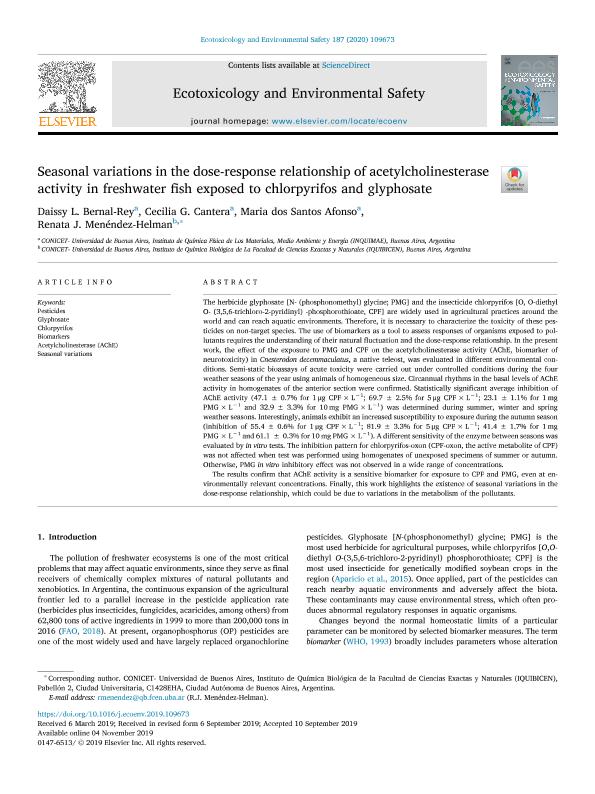Mostrar el registro sencillo del ítem
dc.contributor.author
Bernal Rey, Daissy Lisbeth

dc.contributor.author
Cantera, Cecilia Gisela

dc.contributor.author
Dos Santos Afonso, María

dc.contributor.author
Menendez Helman, Renata Julia

dc.date.available
2021-01-29T12:49:23Z
dc.date.issued
2019-09
dc.identifier.citation
Bernal Rey, Daissy Lisbeth; Cantera, Cecilia Gisela; Dos Santos Afonso, María; Menendez Helman, Renata Julia; Seasonal variations in the dose-response relationship of acetylcholinesterase activity in freshwater fish exposed to chlorpyrifos and glyphosate; Academic Press Inc Elsevier Science; Ecotoxicology and Environmental Safety; 187; 9-2019; 1-9
dc.identifier.issn
0147-6513
dc.identifier.uri
http://hdl.handle.net/11336/124172
dc.description.abstract
The herbicide glyphosate [N- (phosphonomethyl) glycine; PMG] and the insecticide chlorpyrifos [O, O-diethyl O- (3,5,6-trichloro-2-pyridinyl) -phosphorothioate, CPF] are widely used in agricultural practices around the world and can reach aquatic environments. Therefore, it is necessary to characterize the toxicity of these pesticides on non-target species. The use of biomarkers as a tool to assess responses of organisms exposed to pollutants requires the understanding of their natural fluctuation and the dose-response relationship. In the present work, the effect of the exposure to PMG and CPF on the acetylcholinesterase activity (AChE, biomarker of neurotoxicity) in Cnesterodon decemmaculatus, a native teleost, was evaluated in different environmental conditions. Semi-static bioassays of acute toxicity were carried out under controlled conditions during the four weather seasons of the year using animals of homogeneous size. Circannual rhythms in the basal levels of AChE activity in homogenates of the anterior section were confirmed. Statistically significant average inhibition of AChE activity (47.1 ± 0.7% for 1 μg CPF × L−1; 69.7 ± 2.5% for 5 μg CPF × L−1; 23.1 ± 1.1% for 1 mg PMG × L−1 and 32.9 ± 3.3% for 10 mg PMG × L−1) was determined during summer, winter and spring weather seasons. Interestingly, animals exhibit an increased susceptibility to exposure during the autumn season (inhibition of 55.4 ± 0.6% for 1 μg CPF × L−1; 81.9 ± 3.3% for 5 μg CPF × L−1; 41.4 ± 1.7% for 1 mg PMG × L−1 and 61.1 ± 0.3% for 10 mg PMG × L−1). A different sensitivity of the enzyme between seasons was evaluated by in vitro tests. The inhibition pattern for chlorpyrifos-oxon (CPF-oxon, the active metabolite of CPF) was not affected when test was performed using homogenates of unexposed specimens of summer or autumn. Otherwise, PMG in vitro inhibitory effect was not observed in a wide range of concentrations. The results confirm that AChE activity is a sensitive biomarker for exposure to CPF and PMG, even at environmentally relevant concentrations. Finally, this work highlights the existence of seasonal variations in the dose-response relationship, which could be due to variations in the metabolism of the pollutants.
dc.format
application/pdf
dc.language.iso
eng
dc.publisher
Academic Press Inc Elsevier Science

dc.rights
info:eu-repo/semantics/openAccess
dc.rights.uri
https://creativecommons.org/licenses/by-nc-nd/2.5/ar/
dc.subject
ACETYLCHOLINESTERASE (ACHE)
dc.subject
BIOMARKERS
dc.subject
CHLORPYRIFOS
dc.subject
GLYPHOSATE
dc.subject
PESTICIDES
dc.subject
SEASONAL VARIATIONS
dc.subject.classification
Otras Ciencias Biológicas

dc.subject.classification
Ciencias Biológicas

dc.subject.classification
CIENCIAS NATURALES Y EXACTAS

dc.title
Seasonal variations in the dose-response relationship of acetylcholinesterase activity in freshwater fish exposed to chlorpyrifos and glyphosate
dc.type
info:eu-repo/semantics/article
dc.type
info:ar-repo/semantics/artículo
dc.type
info:eu-repo/semantics/publishedVersion
dc.date.updated
2020-11-18T20:11:47Z
dc.journal.volume
187
dc.journal.pagination
1-9
dc.journal.pais
Estados Unidos

dc.description.fil
Fil: Bernal Rey, Daissy Lisbeth. Consejo Nacional de Investigaciones Científicas y Técnicas. Oficina de Coordinación Administrativa Ciudad Universitaria. Instituto de Química, Física de los Materiales, Medioambiente y Energía. Universidad de Buenos Aires. Facultad de Ciencias Exactas y Naturales. Instituto de Química, Física de los Materiales, Medioambiente y Energía; Argentina
dc.description.fil
Fil: Cantera, Cecilia Gisela. Consejo Nacional de Investigaciones Científicas y Técnicas. Oficina de Coordinación Administrativa Ciudad Universitaria. Instituto de Química, Física de los Materiales, Medioambiente y Energía. Universidad de Buenos Aires. Facultad de Ciencias Exactas y Naturales. Instituto de Química, Física de los Materiales, Medioambiente y Energía; Argentina. Universidad Nacional de San Martín. Instituto de Investigación e Ingeniería Ambiental. - Consejo Nacional de Investigaciones Científicas y Técnicas. Oficina de Coordinación Administrativa Parque Centenario. Instituto de Investigación e Ingeniería Ambiental; Argentina
dc.description.fil
Fil: Dos Santos Afonso, María. Consejo Nacional de Investigaciones Científicas y Técnicas. Oficina de Coordinación Administrativa Ciudad Universitaria. Instituto de Química, Física de los Materiales, Medioambiente y Energía. Universidad de Buenos Aires. Facultad de Ciencias Exactas y Naturales. Instituto de Química, Física de los Materiales, Medioambiente y Energía; Argentina
dc.description.fil
Fil: Menendez Helman, Renata Julia. Consejo Nacional de Investigaciones Científicas y Técnicas. Oficina de Coordinación Administrativa Ciudad Universitaria. Instituto de Química Biológica de la Facultad de Ciencias Exactas y Naturales. Universidad de Buenos Aires. Facultad de Ciencias Exactas y Naturales. Instituto de Química Biológica de la Facultad de Ciencias Exactas y Naturales; Argentina
dc.journal.title
Ecotoxicology and Environmental Safety

dc.relation.alternativeid
info:eu-repo/semantics/altIdentifier/doi/https://doi.org/10.1016/j.ecoenv.2019.109673
Archivos asociados
